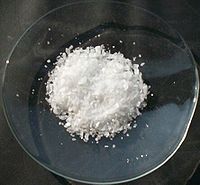
Photo from wikipedia
Although the effect of epibrassinolide (EBL) on plants under boron (B) toxicity has been studied, the participation of l-cysteine desulfhydrase (l-DES) in EBL-induced tolerance to boron toxicity needs to be… Click to show full abstract
Although the effect of epibrassinolide (EBL) on plants under boron (B) toxicity has been studied, the participation of l-cysteine desulfhydrase (l-DES) in EBL-induced tolerance to boron toxicity needs to be uncovered. Therefore, a glasshouse trial was carried out to evaluate what extent l-DES participates in EBL-improved B stress tolerance of pepper plants. Before starting B treatment, 0.5 µM 24-epibrassinolide (EBL) or deionized water (for control treatment) was sprayed to the 10-day-old pepper seedlings every two days for 10 days. Then pepper seedlings were subjected to B toxicity (2.0 mM) in nutrient solution. After starting B treatment, inhibitor of l-DES, 2.0 mM dl-propargylglycine (PAG) was sprayed to plant twice a week. Boron toxicity caused a marked suppression in dry biomass, leaf water potential, leaf relative water, chlorophyll a, chlorophyll b, photosystem II maximum quantum efficiency (Fv/Fm), ascorbate (AsA) and glutathione (GSH) in the pepper seedlings. In contrast, it enhanced the accumulation of malondialdehyde (MDA), hydrogen peroxide (H2O2), electrolyte leakage (EL), free proline, catalase, superoxide dismutase, peroxidase, endogenous hydrogen sulphide (H2S) and l-DES activity. In contrast, foliar spray of EBL promoted key growth characteristics, water relations, levels of free proline and activities of various enzymatic and non-enzymatic antioxidants as well as endogenous H2S and l-DES activity, but it suppressed H2O2 and MDA contents as well as membrane leakage. Foliar application of EBL caused a marked decrease in tissue B concentration but an increase in the contents of leaf Ca2+, K+ and N. Moreover, inhibitor of l-DES, PAG was sprayed to stressed and control plants to assess the role of l-DES in EBL-improved B stress tolerance. Application of PAG inverted the affirmative effects of EBL on oxidative stress and antioxidant defence system by reducing both endogenous H2S and l-DES activities, suggesting that L-DES participates in EBL-induced B toxicity tolerance of pepper plants.
Journal Title: Journal of Plant Growth Regulation
Year Published: 2020
Link to full text (if available)
Share on Social Media: Sign Up to like & get
recommendations!